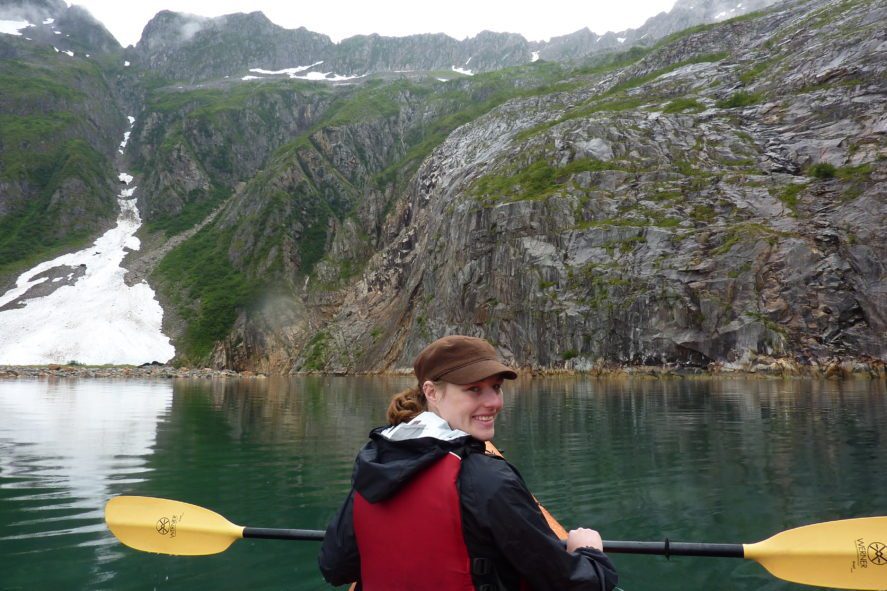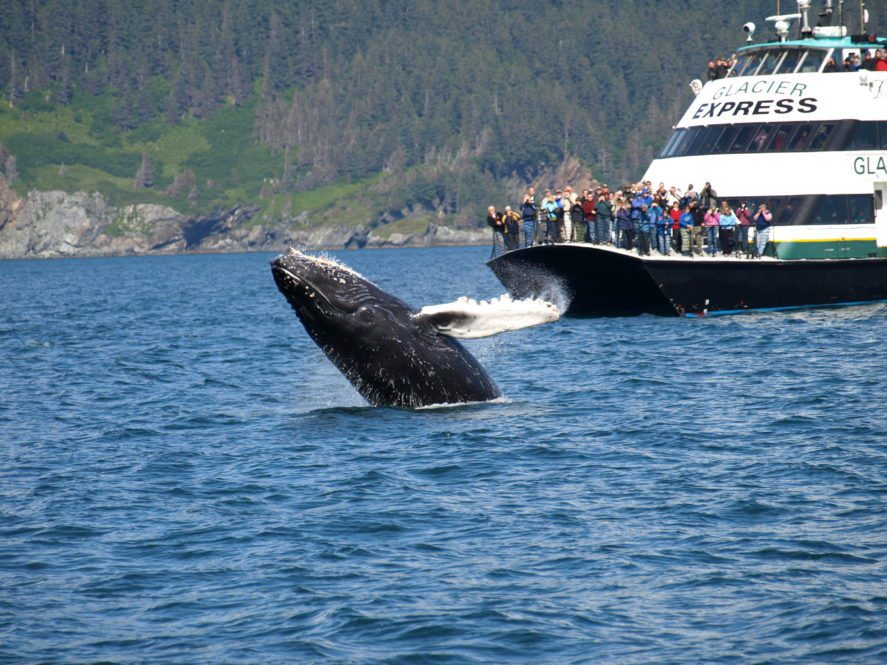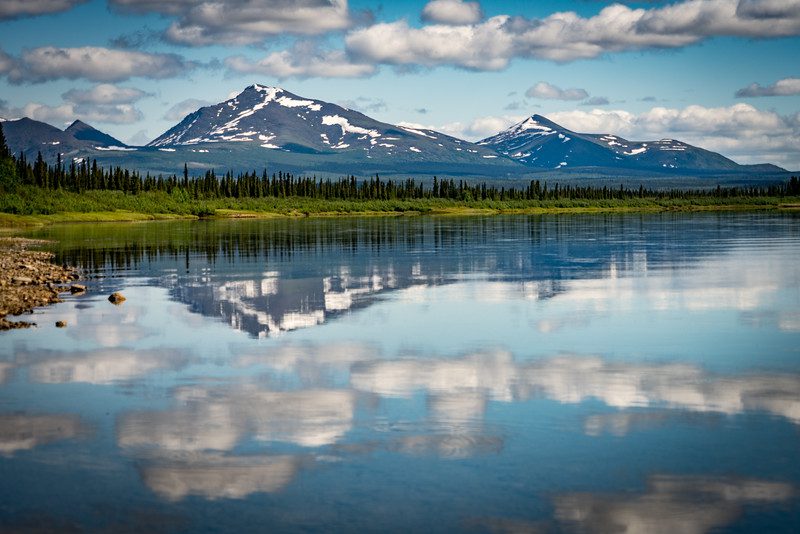Alaska is enormous, and it’s practically bursting with out-of-this-world natural beauty and wonder. It has so many special settings and so much spectacular wildlife that it is home to eight Alaska National Parks covering 54 million acres — not to mention 50 National Historic Landmarks, 16 National Natural Landmarks, 24 official National Park Service units, and nearly 100 state park areas! That’s a whole lot of iconic Alaska to explore, history to relive, animals to observe, and postcard-perfect landscapes to soak up.

Alaska has so many impressive landscapes, and Denali National Park does not disappoint.
Alaska’s national parks offer the full spectrum of landscapes – from Alaska’s alpine awesomeness and marine magic to countless mountains, endless blankets of tundra, tons of towering trees, glaciers galore, and every kind of scenery the state is renowned for — even some unexpected sand dunes! And the wildlife you’ll experience? Diverse and bountiful. There are big bears (the grizzlies of Lake Clark National Park and Katmai National Park), bigger whales (Kenai Fjords National Park, Glacier Bay National Park), and really, really big mountains (Denali National Park, with its namesake peak that’s North America’s tallest, Denali; and also Wrangell-St. Elias National Park).
Some Alaska parks are easily accessible by car, RV, bus, train and bike, while others are so remote that they can only be reached by plane or boat. You can rough it and camp at all the parks, or at a few, opt to rest comfortably at campgrounds, cabins, or lodges. Most Alaska national park tours offer hiking and biking, wildlife viewing, rafting and kayaking, fishing, and other forms of Alaska outdoor fun and adventure.

Kayaking to glaciers in Kenai Fjords National Park
And believe it or not, really ambitious Alaska travelers who have a few weeks for their visit can see all eight parks, and enjoy the best each has to offer, in just one trip. Seriously! That said, you could also spend a dozen days sightseeing in just one park and never run out of new experiences or memorable moments.
No matter which Alaska national park you prefer and how you decide to discover each of them, each provides a healthy escape from the mundane, busy, daily urban life with as much peace, quiet and fresh air as you can breathe in. Many officially became national parks as part of the Alaska National Interest Lands Conservation Act in 1980, but each has its own unique origins. Here’s a snapshot of each park’s offerings and a few of their equally interesting stories.
Denali National Park
Home to Denali (formerly named Mount McKinley), Alaska’s famously striking attraction and North America’s tallest peak at 20,310 feet, this 6 million acre park is set in the center of the state and embodies Alaska’s vastness, wilderness and gorgeousness. Denali National Park is also easy to reach, set off the Parks Highway, one of the state’s main roadways, and along the Alaska Railroad route. The park contains six campgrounds, numerous lodges at the park entry, and another lodge deep within the park.

Day tour in Denali National Park to Kantishna.
There’s just one road inside Denali National Park and like the mountain, it’s a grand one. Mostly unpaved, Denali Park Road travels 92 miles into the heart of the park, offering views of Denali and its giant mountain neighbors, tundra and alpine terrain, and the area’s animals — bears, caribou, moose, sheep, wolves, and more. You won’t see many signs of humans, though, and that’s the point of this park. Anyone can drive the first 15 miles of the road, if weather allows, to Savage River and its campground but after that, Denali Park visitors can only enter by foot, bicycle, or one of the park’s official tour buses, which come with narrated or non-narrated options. Denali bus tours often travel to the end of the road and the Kantishna area, which has a lodge and incredible views of Denali, just 25 miles away. Want to get even closer? Take a flightseeing tour out of Anchorage, Talkeetna or the park entrance, some of which offer glacier landings alongside the famous peak.
Congress created the park in 1917, though not to showcase what was then known as Mt. McKinley. It was formed to protect the area’s Dall sheep from overhunting, then evolved and expanded as visiting and viewing the peak started becoming the popular pursuit it is today.
Katmai National Park
Big bears are a big draw to Katmai National Park, which hosts thousands of enthusiastic visitors and holds international fame thanks to indelible images of bears snatching salmon from the wild waters of Brooks Falls (not to mention a strategically-placed web cam that broadcasts the action live around the world). Katmai is situated in Southwest Alaska, where Bering Sea/Bristol Bay salmon and the volcanic peaks of the Valley of Ten Thousand Smokes are abundant. This place is so special, it was designated a National Park way back in 1918 after the area was devastated by volcanic activity.

Brooks Falls Bears in Katmai National Park
You’d never know that now, as the volcanoes are quiet, the area has returned to vibrant visuals, and a hearty population of huge bears spend the summer hunting those fat, fighting salmon. The bears return to some of the same spots year after year, so it makes bear-viewing thrilling yet easy. In popular bear areas, platforms are set up so visitors can see the action up close and safely. In the viewing areas at Brooks Falls, visitors (which include vacation travelers, Alaskans, professional photographers and scientists) can hear the bruins grunting at one another, snapping their jaws, and even crunching on their fresh catch.
Some visitors come and go in a day – it’s a scenic 2-3 hour flight from Anchorage – while others stay at nearby lodges and enjoy multiday adventures that include more bear viewing in other areas, flightseeing, camping/hiking, and even fishing for some of those plump salmon.
Glacier Bay National Park
The Inside Passage through Southeast Alaska is one of the world’s most spectacular stretches of waterway, traveled by thousands of cruise ship passengers. The unquestioned jewel of those magical marine miles is Glacier Bay National Park, 3.3 million acres of everything that’s distinct about this region.

That includes the wonders within its waters, and many great white glaciers. Some glaciers are miles long and nearly a mile wide, starting high in the mountains and dipping into the seawater, where they calve into chunks that splash down and bob scenically in the water. Equally impressive and even more active is the area’s marine wildlife: Humpbank whales, orcas (killer whales), harbor seals, Stellar sea lions, sea otters, harbor porpoises and many fish. Getting close to this activity is easy, whether by kayak, boat and yacht glacier tours, and guided fishing trips.
Glacier Bay’s pull isn’t exclusive to the water. On land, there’s seemingly endless rain forest and majestic mountains, many wrapped by glaciers, those rivers of ice carving their way toward water. Southeast is also home to bears (brown and black), moose and sheep, as well as some of Alaska’s most luxurious lodges, coolest campgrounds and inspiring hiking trails. And while the region became a national park in 1980, there are the plenty of opportunities to learn about the human history that spans thousands of years: from explorers to the area’s Tlingit culture, which is on display at the Huna Tribal House and other places in Bartlett Cove.
And in Glacier Bay National Park, there’s even world-class activity in the air. Countless birds flock through the area, and flightseeing trips give passengers a bird’s eye view of one of our country’s grandest national parks.
Wrangell-St. Elias National Park
How’s this for national park prestige? Wrangell-St. Elias National Park is America’s largest national park at 13.2 million acres, which, according to the National Park Service, is the size of Yellowstone and Yosemite national parks plus the country of Switzerland combined. Size is just the start of what makes this park so phenomenal. The park touches sea level at the Gulf of Alaska and reaches its highest point at 18,008 feet on the summit of Mt. St. Elias. Four major mountain ranges cross the park – Wrangell, St. Elias, Chugach and the Alaska Range – and nine of the nation’s 16 tallest peaks are set here. One of its many massive glaciers, Malaspina, is larger than Rhode Island, while another, Nabesna, is nearly 80 miles long. And like these glaciers, the list of this park’s personality traits goes on and on…

Wrangell-St. Elias National Park view from McCarthy
One of the best features of Wrangell-St. Elias is its accessibility for visitors. The Richardson Highway, Glenn Highway and Edgerton Highway all travel the outskirts of the park, which is met in the east by the Kluane National Park on the Canada border. Visitors can drive, take a bus/shuttle, or even fly into the park and to the copper mining ghost towns of Kennecott/McCarthy at the end of the scenic 60-mile McCarthy Road. There are lodges and cabins, as well as campgrounds, around the park.
Visitors certainly won’t run out of things to do once they’re settled in: there are guided tours of the mining areas and infrastructure, opportunities to learn about the area’s boom and bust copper mining history, as well as the Alaska Native cultural presence. And then there’s guided exploration of nearby glaciers, classic Alaska hiking, backpacking and camping in every direction, mountain biking, rafting, and even fishing and hunting. A flightseeing tour over the park provides a priceless perspective of its peaks, glaciers and forests. No matter where you are in the park, keep your eyes open for wildlife. Bears, moose, caribou and sheep are everywhere.
Wrangell St. Elias National Park was created in 1980 to protect and spotlight its incredible environment as well as its cultural resources like archeological sites, cultural landscapes, ethnographic resources, museum objects and structures. This park really has it all.
Kenai Fjords National Park
Kenai Fjords National Park redefines most expectations of a “traditional” national park. This park is covered by icy glaciers, bordered by the marine-life-filled waters of Resurrection Bay in the Gulf of Alaska, and, of course, dotted by fjords, dramatic inlets squeezed inside high, tight glacier carved cliffs. The charming fishing town of Seward, just a two-hour drive south of Anchorage, is the gateway to the park and a gem in its own right.

Kenai Fjords National Park Day Cruise
At 670,000 acres, set on the Kenai Peninsula, Kenai Fjords National Park is one of Alaska’s smallest national parks. A big, bright chunk of that acreage is held by the Harding Icefield. Whether by hiking trail or flightseeing plane, views of the icefield resemble an ocean of snow, glacial crevasses and mountains set well above sea level. You don’t have to climb to see it up close, though. One of the park’s highlights is Exit Glacier, which is a very short drive from Seward. After visiting the Exit Glacier Nature Center, visitors can literally walk up to Exit Glacier, feel cold radiating from it and the icefield above, and hear it snapping, crackling and popping.
But Kenai Fjords gets even more exciting beyond its glaciers and marine life. There are hiking trails and campgrounds around the park, and with them chances to see moose, sheep and bears. On the water, large boats and small water taxis take visitors on glacier tours, fishing trips, and drop-offs at lodges or camping areas. The most intimate and unique way to travel through the park is by kayak. Paddling into a fjord is an unforgettable experience: surrounded by glaciers, mountains and forest, an occasional puffin flying by, a salmon jumping, or an otter crunching on a shell. Pull up on a beach for lunch and a break. This is truly an Alaska national park unlike any other.
Lake Clark National Park
Though just 120 air miles southwest of Anchorage and even closer to Kenai Peninsula towns like Homer, Soldotna and Kenai, arriving in Lake Clark National Park from an Alaska city feels like stepping into a completely different universe. While the towns certainly have their own natural splendor, Lake Clark’s landscapes and legacy are deeper, richer and amplified. And while there are countless roads in Alaska’s urban areas, there are none in Lake Clark. That said, both areas have plenty of traffic. In Anchorage and on the Kenai Peninsula, there’s a familiar hum of automobiles and buzzing of planes while in Lake Clark, it’s the wildlife – from amazing salmon runs of Bristol Bay sockeye to the hundreds of hungry, hulking brown bears hunting them each summer.

Lake Clark offers some comforts of civilization like lodges and dining, cabins, and transportation on planes, boats (water taxis, kayaks, canoes, rafts) and ATVs. Nightlife here though takes place under the Midnight Sun and hustle and bustle includes watching bears feed on salmon and strolling on beaches and tundra, perusing one of the park’s volcanoes, seeing birds fly by outside your tent, or catching a salmon of your own along Cook Inlet or in one of the park’s numerous lakes and streams.
Lake Clark National Park is 4 million acres of variety: mountains and glaciers, forests and tundra, and oh so many rivers, streams, lakes and ponds. The area’s timeless run of salmon also spawned nearly 10,000 years of fascinating human activity, as evidenced by numerous archaeological sites and current Alaska Native residents.
Gates of the Arctic National Park
Alaska doesn’t get much more extreme than in the Arctic, where weather, wildlife and the land itself can be beautifully unbelievable one moment and brutally unforgiving the next. Set above the Arctic Circle in the rugged Brooks Range 200 miles north of Fairbanks, the Gates of the Arctic National Park embodies these extremes.

It’s one of America’s largest national parks, yet it’s also one of the least-visited. In the summer, the Midnight Sun blasts big and bright 24 hours a day; in other seasons, it’s practically all dark or dusky, except for some displays of dancing northern lights. For about half the year, temperatures hover around zero. Even the silence is extreme here – there are no signs of people: towns, roads, WiFi or cell service, lodges, trails, bathrooms or ranger stations. Nothing. And that’s the draw for around 10,000 visitors that come to the park every year – escape, adventure, untouched vistas.
The park is known as one of America’s wildest places but is also a paradise for seasoned and savvy hikers, backpackers and mountain climbers who bound around the Brooks Range, and kayakers, canoers and rafters who travel the Noatak River. Even getting into the park is an expedition as most take a small plane from Fairbanks to Bettles, stop by the park’s ranger station and visitor’s center there, then continue into the park via air taxi (often a float plane).
Gates of the Arctic reached national park status in 1980, protecting 8.5 million acres of land to “maintain the wild and undeveloped character of the area, including opportunities for visitors to experience solitude,” notes the National Parks Service, which also safeguards the habitat for fish and wildlife, including thousands of caribou that have traversed the area for ages.
Kobuk Valley National Park
Sand dunes in Alaska? Sand dunes in Alaska! Yes, Kobuk Valley National Park has vast patches of sand dunes, some piled 10 feet high. And that’s just the start of what makes this remote Alaska park so astounding. Sandwiched by the Baird Mountains and Waring Mountains above the Arctic Circle in Northwest Alaska, Kobuk Valley is 1.7 million acres of surprising Alaska amazement.

Kobuk Valley National Park view (Source: everything-everywhere.com)
How are there sand dunes in the northern reaches of Alaska? Glaciers and wind, which deposited the silt and sand into the concentrated area surrounded by mountains. Contrasting the Great Kobuk, Little Kobuk and Hunt River sand dunes are the lush wetlands that follow the Kobuk River, which cuts its way through the south end of the park. Hundreds of thousands of caribou also traverse the area, a mind-blowing sight. Humans have followed the herds for 10,000 years, so there’s a rich history here, not to mention ancient artifacts and fossils that date back to the Ice Age. Learn all about the area’s past and present at the Northwest Arctic Heritage Center in Kotzebue, home to the park’s headquarters.
Visitors can spend days exploring the dunes, but there are also backpacking, camping and hiking options, as well as fishing and boating in the summer, and for the very bold traveler, snowmachining and dog mushing in the winter.
Ready to come for a visit to one of our amazing national parks? Let’s go
